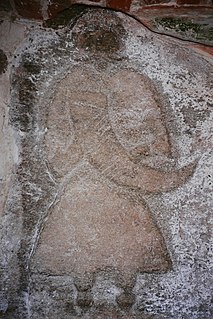 W
WSlavic paganism or Slavic religion describes the religious beliefs, myths and ritual practices of the Slavs before Christianisation, which occurred at various stages between the 8th and the 13th century. The South Slavs, who likely settled in the Balkan Peninsula during the 6th–7th centuries AD, bordering with the Byzantine Empire to the south, came under the sphere of influence of Eastern Orthodox Christianity, beginning with the creation of writing systems for Slavic languages in 855 by the brothers Saints Cyril and Methodius and the adoption of Christianity in Bulgaria in 863. The East Slavs followed with the official adoption in 988 by Vladimir the Great of Kievan Rus'.
 W
WBałwan (Polish); balvan/балван (Kyrgyz, bolvan/бoлван, archaism for "idol", is an ancient word common to all Slavic languages, describing a statuesque or monolithic depiction or a pillar or a plinth depicting or erected in honor of a deity. This object was worshipped or constituted a tangible representation of a cult image. The Western Slavs transcribed and pronounced the word as bałwan, which is its contemporary and old Polish lexical manifestation, whereas most Southern Slavs and the Eastern Slavs used the just slightly differently-vowelled bolvan.
 W
WIn Slavic mythology, Chernava is Morskoy Tsar's daughter, spirit and personification of the river of the same name. She is a mermaid. Her head and upper body are human, while the lower body is a fish's tail. Chernava is famous by the epic of Sadko, where she appears.
 W
WIn the Slavic religious tradition, Domovoy is the household god of a given kin. They are deified progenitors, that is to say the fountainhead ancestors of the kin. According to the Russian folklorist E. G. Kagarov, the Domovoy is a personification of the supreme Rod in the microcosm of kinship. Sometimes he has a female counterpart, Domania, the goddess of the household, though he is most often a single god. The Domovoy expresses himself as a number of other spirits of the household in its different functions.
 W
WMarzanna, Marena, Mara, Morana, Morena or Mora is a pagan Slavic goddess associated with seasonal rites based on the idea of death and rebirth of nature. She is an ancient goddess associated with winter's death, rebirth and dreams. In ancient Slavic rites, the death of the Goddess Marzanna at the end of winter becomes the rebirth of Spring of the Goddess Kostroma (Russian), Lada or Vesna representing the coming of Spring.
 W
WThe Ovinnik, Joŭnik or Jownik is a malevolent spirit of the threshing house in Slavic folklore. He is prone to burning down the threshing houses by setting fire to the grain. To placate him, peasants would offer him roosters and bliny. On New Year's Eve, the touch of an Ovinnik would determine their fortune for the New Year. A warm touch meant good luck and fortune, while a cold touch meant unhappiness.
 W
WA skomorokh was a medieval East Slavic harlequin, or actor, who could also sing, dance, play musical instruments and compose for oral/musical and dramatic performances. The etymology of the word is not completely clear. There are hypotheses that the word is derived from the Greek σκώμμαρχος ; from the Italian scaramuccia ; from the Arabic masẋara; and many others.
 W
WIn Slavic paganism there are a variety of female tutelary spirits associated with water. They have been compared to the Greek Nymphs, and they may be either white (beneficent) or black (maleficent). They may be called Boginka literally "little goddess", Navia, Rusalka, and Vila.
 W
WIn Slavic mythology, vodyanoy or vodyanoi is a male water spirit. Vodník, in Czech fairy tales, is the same creature as the Wassermann or nix of German fairy tales.
 W
WA volkhv or volhv is a priest in ancient Slavic religions and contemporary Slavic Native Faith (Rodnovery). The term volkhv is a cognate of Old Norse völva.
 W
WThe Zbruch Idol, Sviatovid is a 9th-century sculpture, more precisely an example of a bałwan, and one of the few monuments of pre-Christian Slavic beliefs, according to another interpretation was created by the Kipchaks/Cumans. The pillar was commonly incorrectly associated with the Slavic deity Svetovid, although current opinions on the exact meaning of all the bas-reliefs and their symbols differ. It is thought that the three tiers of bas-relief represent the three levels of the world, from the bottom underworld, to the middle mortal world and the uppermost, largest, world of heavenly gods.